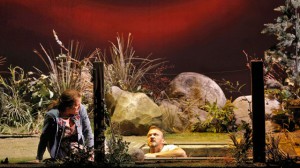A Stephen King novel is really weird source material for an opera. Honestly, it would be a strange choice even for a musical, as evidenced by the notorious Broadway flop Carrie, which was eventually retooled into a respectable off-Broadway hit decades later (and will have its much-belated West Coast premiere with San Francisco’s Ray of Light Theatre in October). Nevertheless, San Francisco Opera now unveils its commissioned world premiere Dolores Claiborne, based on the King novel of the same name, composed by Tobias Picker (Emmeline, Fantastic Mr. Fox)
Even among the prolific horror writer’s works, Dolores Claiborne is a curious choice, because the story’s much more intimate than epic. All told in one meandering first-person monologue, it’s the story of a lifetime housekeeper and caretaker on a small Maine island, the murder she’s accused of, and the other one she actually committed long ago. (That’s not much of a spoiler, because she spills the beans on that right off the bat in the book, though the opera is coyer about it.) The feisty Dolores holds court in her confession to the local police with lots of hold-your-horses chiding to the cops she’s known since they were kids and just-us-girls asides to the stenographer. She gets around to the gruesome stuff eventually, but not until you’ve heard more than you ever wanted to know about the proper way to hang up bedsheets to dry.
The 1992 novel was made into a 1995 movie starring Kathy Bates, and in fact the book reads like it was written specifically to be made into a movie with Bates, who’d recently won an Academy Award for her role in Misery. It’s all written in folksy, somewhat cutesy dialect with lots of colorful exclamations like “gorry” and “jeezly-crow,” making it easier to picture Bates speaking it than to actually read it on the page. (“And if you don’t like it, Andy Bissette, you can write it up on your T.S. list and mail it to the chaplain,” Dolores says in a fairly typical line.)
The titular drudge is played by soprano Patricia Racette, an acclaimed company mainstay who also costars in SF Opera’s current production of Arrigo Boito’s Mefistofele and who stepped in when mezzo-soprano Dolora Zajick withdrew from the role of Dolores less than a month ago. Racette is performing the first four shows, whereupon Catherine Cook will take over for the last two. Racette sings the role awfully well, despite the fact that it’s a generally unpleasant part to hear, with lots of short, sharp wails of pathos.

Susannah Biller (Selena), Elizabeth Futral (Vera Donovan) and Patricia Racette (Dolores Claiborne)




